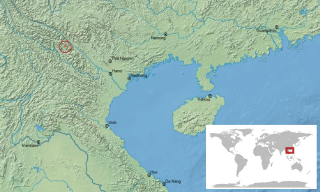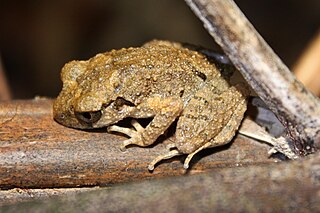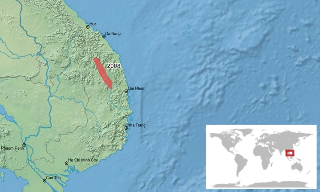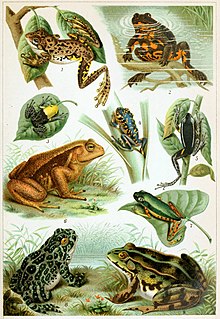
Leptolalax is a genus of frogs in the family Megophryidae. They are sometimes known as Asian toads, metacarpal-tubercled toads, or slender litter frogs, although many species-specific common names do not follow these conventions, and many species do not have common names. They are widely distributed in southeastern and eastern Asia, from southern China and northeastern India to the Malay Peninsula and Borneo. Leptolalax are typically small and have a cryptic colour pattern and no obvious morphological characters useful in systematic studies. Consequently, both molecular genetic analyses and analysis of advertisement calls by male frogs have been important in identifying new species.
Leptolalax alpinus is a frog species in the family Megophryidae. It is endemic to Jingdong County in Yunnan, China, where it occurs in Wuliangshan National Nature Reserve.

Leptolalax bourreti is a frog species in the family Megophryidae. It is known with certainty only from the vicinity of its type locality in Sa Pa in northern Vietnam. Earlier records from Laos refer to Leptolalax eos and those from Thailand probably to an unnamed species. Its natural habitats are subtropical moist lowland forests, moist montane forests, and rivers. Its status is insufficiently known.
Leptolalax heteropus is a frog species in the family Megophryidae. It is found in the Malay Peninsula, both in Malaysia and southern Thailand. The type locality is Maxwell Hill in Taiping, Perak, Malaysia. Its natural habitats are tropical moist lowland forests, moist montane forests, and rivers. It is not considered threatened by the IUCN.
Leptolalax kajangensis is a species of amphibian in the family Megophryidae. It is endemic to Malaysia and only known from its type locality, a small cave near the top of Gunung Kajang, on Tioman Island, a small island located 32 km off the east coast of Peninsular Malaysia.

Leptolalax liui is a frog species in the family Megophryidae. Originally described from Chong'an in Fujian, it is now known to be widely distributed in southern and southeastern China from Zhejiang and Fujian west to Guizhou and Guangxi. Its natural habitats are subtropical moist lowland forests, moist montane forests, subtropical or tropical high-altitude grassland, and rivers. It is not considered threatened by the IUCN.
Leptolalax oshanensis (Oshan metacarpal-tubercled toad or pigmy crawl frog) is a frog species in the family Megophryidae. It is endemic to southern–central China (Guizhou, Hubei, and Sichuan provinces). Its type locality is Mount Emei (Chinese: 峨嵋山; pinyin: Éméi Shān; Wade–Giles: O2-mei2 Shan1). The same mountain has given the species its name, although this is now obscured because "Oshan" is a contraction of the transliteration that is no longer widely used, Omeishan. It has also been reported from Thailand and Laos but these are now considered to represent Leptolalax minimus.
Leptolalax pelodytoides is a frog species in the family Megophryidae. It is known with reasonable certainty only from near its type locality, the Karen Hills region in the Kayah State, eastern Myanmar. As Leptolalax pelodytoides was one of the first megophryid species to be described from the region, later research has shown that many specimens that have been reported as L. pelodytoides represent other species, including Leptolalax bourreti, Leptolalax oshanensis, Leptolalax eos, and Leptolalax minimus. A consequence is that the most recent IUCN assessment reports much broader distribution for this species than what can be ascertained.

Leptolalax pluvialis is a frog species in the family Megophryidae. It is only known from its type locality, Fansipan mountain range in northern Vietnam, although it is expected to be found also in adjacent Yunnan, China. Its natural habitats are subtropical moist montane forests and rivers. Its status is insufficiently known.

Leptolalax sungi is a frog species in the family Megophryidae. It is found in Vĩnh Phúc and Lào Cai Provinces in northern Vietnam and in Guangxi in southern China. Its natural habitats are subtropical moist lowland forests, moist montane forests, and rivers. Its status is insufficiently known. This species was first found along a stream near Tam Đảo village, about 925 meters ASL.

Leptolalax tuberosus is a frog species in the family Megophryidae. It is endemic to Vietnam and known only from the central highlands of the country. Its natural habitats are tropical moist lowland forests, moist montane forests, and rivers. It is threatened by habitat loss.
Leptolalax ventripunctatus is a frog species in the family Megophryidae. It is known from Mengla County in Yunnan, southern China, from Phongsaly Province in northern Laos, and from Tam Dao in northern Vietnam. Its natural habitats are subtropical moist lowland forests and rivers. Its status is insufficiently known.
Leptolalax tamdil is an anuran amphibian belonging to the family Megophryidae. It is so far reported only from Tam Dil lake, Mizoram, India. It is a small frog, but medium-sized among Leptolalax species; the male measuring 32.3 mm, and female 31.8 mm. The species is diagnosed with unique features such as eyelids with tubercles, distinct tympanum and supratympanic folds, undilated toe tips with dermal fringes, long hind limbs, and distinct color patches.
Leptolalax applebyi is a species of frogs in the family Megophryidae. It is endemic to Vietnam where it is only known from near its type locality, Song Thanh Nature Reserve, Phước Sơn District in Quảng Nam Province of central Vietnam.
Leptolalax fuliginosus is a frog species in the family Megophryidae. It is endemic to Thailand where it is only known from its type locality, Pa Lao U in Prachuap Khiri Khan Province. Only four specimens were collected, all of them males, measuring 28–30 mm (1.1–1.2 in) in snout-vent length.
Leptolalax solus is a frog species in the family Megophryidae. It is endemic to Thailand where it is only known from its type locality, Hala Bala Wildlife Sanctuary in Narathiwat Province near the Malaysian border; it is likely that its range extends to Malaysia. The type collection consists of a single adult frog, which measured 28 mm (1.1 in) in snout-vent length.
Leptolalax croceus is a species of toads in the family of Megophryidae, discovered in the Central Vietnam in 2010. It is endemic to Vietnam as it is only known from its type locality, Ngoc Linh Nature Reserve in Đắk Glei District, Kon Tum Province. However, given the vicinity of the border to Laos it is also likely to be found there. Its belly has light orange color, which is unique among Leptolalax. It is a medium-sized species within its genus: snout-vent length of 16 males was in the range 22–27 mm (0.87–1.06 in). The species was found from evergreen forest at about 1,300 m (4,300 ft) elevation.
Leptolalax melicus is a frog species in the family Megophryidae. It is endemic to Cambodia where it is only known from near its type locality, Virachey National Park, Ratanakiri Province; it is expected to have a wider distribution that may reach Laos and Vietnam. Leptolalax melicus have only been found near rocky streams in evergreen forest between 650–850 m (2,130–2,790 ft) altitude.
Leptolalax aereus is a species of frogs in the family Megophryidae. It is known from Vilabouli District, Savannakhet Province, Laos and from Hà Tĩnh, Nghệ An, and Quảng Bình Provinces of Vietnam. Leptolalax aereus from Laos were associated with rocky streams in semi-evergreen and evergreen forest at altitudes of about 280–510 m (920–1,670 ft). It seems to tolerate some degree of habitat degradation. The species is not yet assessed by IUCN, but given its wide distribution, Ohler et al. suggest to classify Leptolalax aereus as of "Least Concern".









